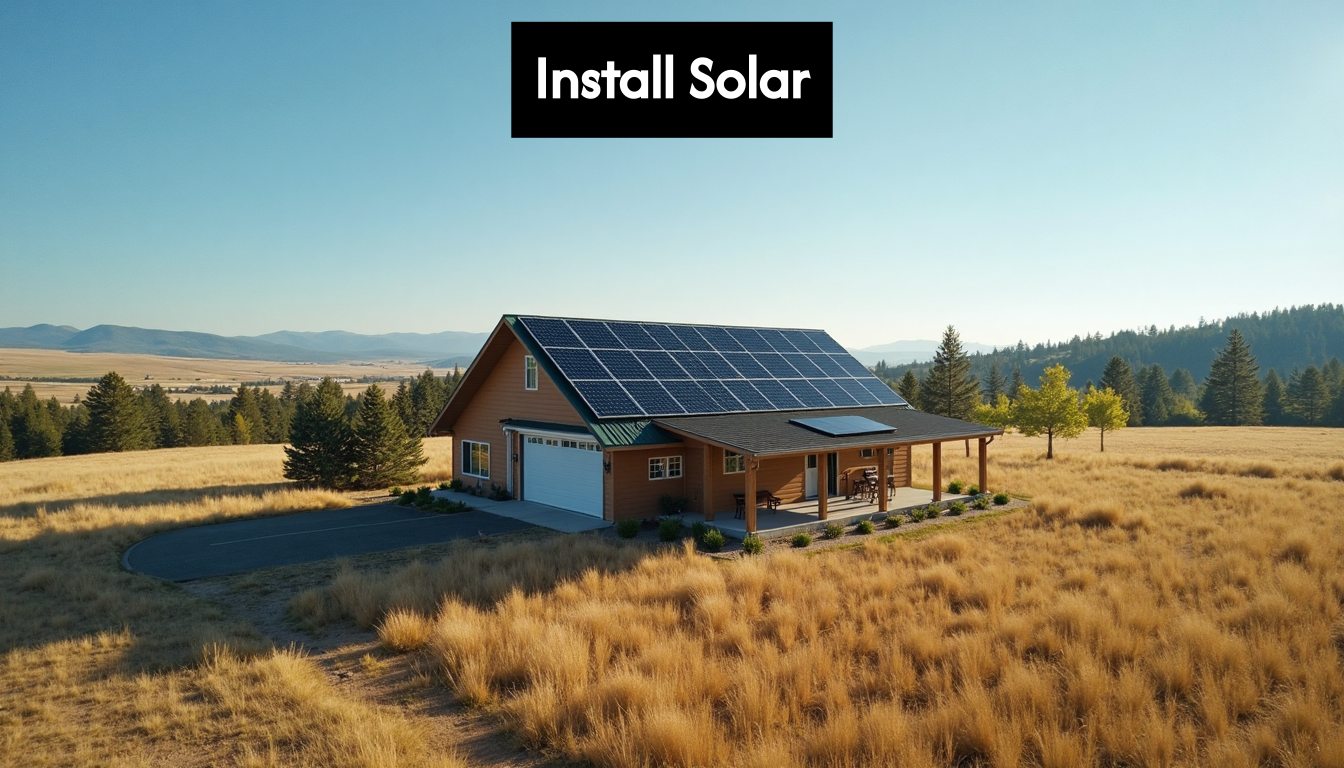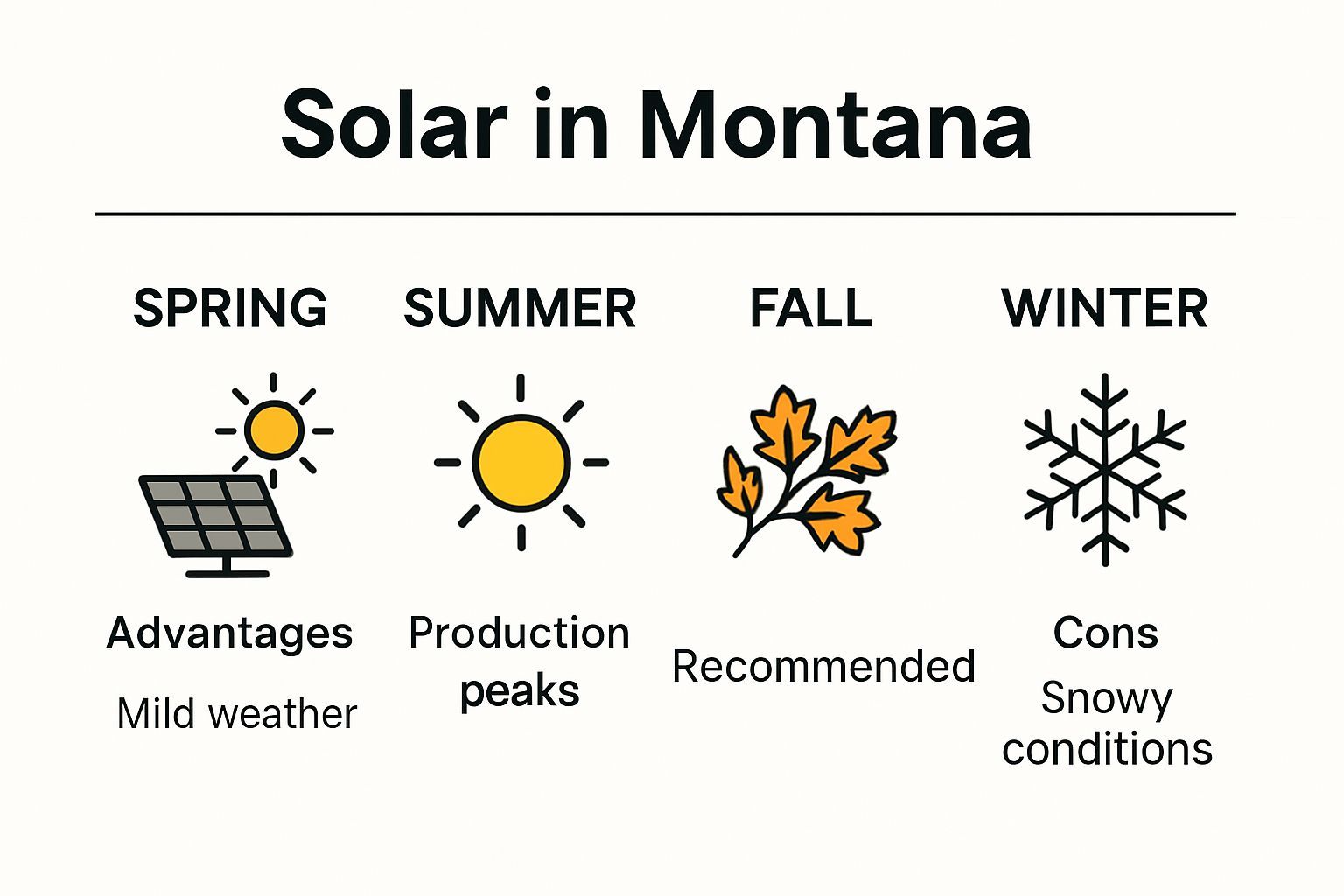Best Times to Install Solar in Montana: 2025 Guide for Homeowners and Businesses
Contact Us

Montana homeowners and business owners are looking to solar for serious energy savings, but most miss the real secret to maximizing returns. Installing solar panels in winter or early spring can let you capture Montana’s peak summer sunlight and potentially save you up to 30 percent right out the gate through the federal tax credit. Yet, the best season isn’t what everyone expects. Timing your installation right—long before the summer rush—unlocks hidden financial and energy-generating advantages that most Montanans overlook.
Table of Contents
- Seasonal Differences For Solar Installation
- Summer Solar Performance: Peak Energy Generation
- Winter Challenges And Preparation
- Spring Maintenance: Preparing For Peak Performance
- Key Factors: Weather, Costs, And Incentives
- Weather Performance And Solar Efficiency
- Financial Considerations And Incentives
- Strategic Installation Planning
- Timing Tips For Montana Property Owners
- Best Seasonal Installation Windows
- Regulatory And Permitting Considerations
- Property Specific Assessment Strategies
- Solar Planning For Rural And Off-Grid Needs
- System Design And Energy Requirements
- Funding And Financial Support
- Winter Performance And Resilience
Quick Summary
| Takeaway | Explanation |
|---|---|
| Optimal Summer Installation | Install solar systems during winter or early spring to ensure they are operational before peak summer, maximizing energy production. |
| Seasonal Maintenance Importance | Conduct comprehensive spring maintenance to prepare solar systems for optimal performance during summer months, including cleaning and system checks. |
| Financial Incentives Awareness | Take advantage of the 30% federal solar tax credit and explore state-specific incentives for significant cost reductions on solar installations. |
| Regulatory Preparedness | Gather all necessary documentation and understand local permitting processes well in advance to prevent delays in installation. |
| Rural Systems Adaptions | Rural installations should be designed for specific energy needs and integrate robust battery storage to handle low sunlight periods efficiently. |
Seasonal Differences for Solar Installation
Solar installations in Montana demand strategic planning due to the state's unique seasonal variations. Understanding how seasonal changes impact solar performance helps homeowners and businesses maximize their renewable energy investments.

Summer Solar Performance: Peak Energy Generation
Montana summers provide exceptional solar energy potential. During June through August, the state experiences extended daylight hours and consistently clear skies, creating optimal conditions for solar panel efficiency. PowerOutage.us confirms that summer months deliver maximum solar energy generation, with panels capturing substantial sunlight during long daylight periods.
Typical summer solar performance in Montana includes:
- High solar irradiance with minimal cloud interference
- Peak daylight hours extending up to 15 hours in June and July
- Ambient temperatures that support optimal photovoltaic panel efficiency
Solar systems installed with proper southern exposure can generate significantly more electricity during these months, potentially offsetting lower winter production.
Winter Challenges and Preparation
Winter presents unique challenges for solar installations in Montana. Contrary to common misconceptions, solar panels can still generate electricity during cold months, though at reduced capacities. Snow accumulation and shorter daylight hours impact overall system performance.
- Next Energy AI recommends proactive winter maintenance strategies, including: Snow removal techniques to maintain panel accessibility
- Angle adjustments to maximize limited winter sunlight
- Regular system inspections to ensure structural integrity
Modern solar panel technologies are designed to withstand Montana's harsh winter conditions. Many panels feature anti reflective coatings and can generate electricity even when partially covered in snow. The key is strategic installation and system design that accounts for seasonal variations.
Spring Maintenance: Preparing for Peak Performance
Spring emerges as a critical season for solar system optimization. After winter's challenges, homeowners and businesses should conduct comprehensive system assessments. Cleaning panels, checking electrical connections, and evaluating overall system health ensures maximum summer performance.

Professional solar technicians recommend comprehensive spring maintenance, which includes:
- Detailed panel cleaning to remove winter debris
- Electrical system diagnostics
- Performance efficiency evaluations
- Potential minor repairs or adjustments
By understanding and preparing for Montana's seasonal solar differences, property owners can design resilient renewable energy systems that provide consistent, reliable electricity throughout the year. Proper planning transforms seasonal variations from potential challenges into opportunities for sustainable energy generation.
Key Factors: Weather, Costs, and Incentives
Installing solar panels in Montana requires a comprehensive understanding of multiple critical factors that influence long term success and financial viability. Weather conditions, installation costs, and available incentives play pivotal roles in determining the optimal solar strategy for homeowners and businesses.
Weather Performance and Solar Efficiency
Montana's unique climate presents both challenges and opportunities for solar energy generation. Montana Department of Environmental Quality research reveals that cooler temperatures can actually enhance solar panel efficiency, contrary to common misconceptions about northern state solar potential.
Key weather considerations for solar installations include:
- Temperature Impact: Cooler temperatures improve photovoltaic panel performance
- Annual Consistency: Solar energy production remains relatively stable throughout different years
- Snow Reflection: Snow can provide additional light reflection, potentially increasing energy generation
Modern solar technologies are engineered to withstand Montana's extreme weather variations, ensuring robust performance across seasonal transitions.
Financial Considerations and Incentives
2025 presents an exceptional window for solar investments in Montana. Missoula Current highlights the federal solar tax credit, which currently covers 30% of total system installation costs. This substantial incentive significantly reduces initial financial barriers for residential and commercial solar adopters.
Financial breakdown of solar investments includes:
- Federal Tax Credit: 30% of total system costs
- Potential State Incentives: Additional Montana specific rebates
- Long Term Energy Savings: Reduced electricity expenses over system lifetime
Investors can expect considerable financial benefits when strategically timing their solar panel installations to maximize available incentives.
Strategic Installation Planning
Successful solar implementation in Montana demands careful planning that balances technological capabilities with financial opportunities. Homeowners and businesses should consider comprehensive factors beyond immediate costs, including:
- Energy consumption patterns
- Property specific solar potential
- Long term sustainability goals
- Available roof or ground space for panel installation
By thoroughly evaluating these interconnected elements, Montana residents can design solar solutions that provide maximum economic and environmental benefits. The convergence of advanced solar technologies, attractive financial incentives, and Montana's unique solar potential creates an unprecedented opportunity for renewable energy adoption in 2025.
Timing Tips for Montana Property Owners
Timing solar installations in Montana requires strategic planning that considers unique regional characteristics, regulatory environments, and seasonal variations. Property owners must navigate complex factors to optimize their renewable energy investments and ensure smooth project implementation.
Best Seasonal Installation Windows
Big Dog Solar recommends scheduling solar installations during winter or early spring months. This counterintuitive approach allows systems to be fully operational before peak summer sunlight, enabling homeowners to maximize energy production and accumulate net metering credits.Strategic timing advantages include:
- Winter Planning: Lower installation demand reduces scheduling complications
- Early Spring Setup: Systems become fully functional before peak summer energy generation
- Permit Processing: Reduced seasonal workload for local authorities expedites approvals
By implementing solar systems during off peak seasons, property owners can strategically position themselves for maximum energy efficiency and financial benefits.
Regulatory and Permitting Considerations
Power Outage US highlights significant variations in permitting processes across Montana. Rural areas typically experience more streamlined regulatory requirements, while urban centers often implement stricter building codes and homeowners association regulations. Key permitting recommendations include:
- Early Documentation: Gather all necessary paperwork months in advance
- Local Code Research: Understand specific municipal solar installation guidelines
- Professional Consultation: Work with local solar experts familiar with regional regulations
Careful preparation can significantly reduce potential delays and unexpected complications during the solar installation process.
Property Specific Assessment Strategies
Successful solar implementation demands comprehensive property evaluation. Montana property owners should conduct thorough assessments that consider unique landscape characteristics, roof orientation, potential shading, and energy consumption patterns.
Recommended assessment steps:
- Professional Site Evaluation: Detailed solar potential analysis
- Energy Consumption Audit: Understanding current and projected energy needs
- Structural Compatibility: Assessing roof condition and load bearing capacity
- Future Expansion Planning: Designing systems with potential growth in mind
By approaching solar installations with meticulous planning and regional expertise, Montana property owners can transform renewable energy investments into long term sustainable solutions. The key lies in understanding local nuances, leveraging seasonal opportunities, and maintaining flexibility throughout the implementation process.
Solar Planning for Rural and Off-Grid Needs
Rural Montana property owners face unique challenges and opportunities when implementing solar energy solutions. Designing off-grid and rural solar systems requires specialized strategies that address the distinctive environmental and infrastructure constraints of remote locations.
System Design and Energy Requirements
Montana Renewables recommends tailoring solar installations to specific rural energy consumption patterns. For most Montana residents, solar systems ranging between 4kW and 7kW provide sufficient energy generation, though precise sizing depends on individual household needs.Key considerations for rural solar system design include:
- Energy Consumption Analysis: Detailed assessment of daily and seasonal energy requirements
- Battery Storage Capacity: Robust storage solutions to manage energy during low sunlight periods
- System Scalability: Designing systems that can be expanded as energy needs evolve
Successful rural solar planning demands a comprehensive approach that anticipates both current and future energy demands.
Funding and Financial Support
USDA Rural Energy for America Program offers critical financial support for agricultural producers and rural small businesses seeking solar installations. These guaranteed loan financing and grant options significantly reduce initial investment barriers.Financial support strategies for rural solar projects include:
- REAP Grant Applications: Exploring federal funding opportunities
- State Level Incentives: Investigating Montana specific renewable energy programs
- Tax Credit Optimization: Maximizing available federal and state tax benefits
Careful financial planning can transform solar investments from significant expenses into long term economic advantages for rural property owners.
Winter Performance and Resilience
State Solar Montana emphasizes the importance of designing solar systems capable of withstanding harsh winter conditions. Rural and off-grid installations must incorporate robust technologies that maintain reliable electricity supply during extended periods of reduced sunlight.Winter solar performance strategies include:
- Enhanced Battery Technologies: High capacity storage systems
- Angle Optimization: Panel positioning to maximize limited winter sunlight
- Supplemental Heating Systems: Integrated solutions to prevent equipment freezing
- Redundant Power Sources: Backup generation capabilities
By implementing comprehensive planning strategies, rural Montana property owners can develop solar solutions that provide consistent, reliable energy regardless of seasonal challenges. The key lies in understanding unique regional requirements, leveraging available financial support, and designing systems with exceptional resilience and adaptability.
Frequently Asked Questions
When is the best time to install solar panels in Montana?
Installing solar panels in winter or early spring allows you to capitalize on peak summer sunlight, maximizing energy generation and potential savings.
How does Montana's weather affect solar panel efficiency?
Montana's cooler temperatures can enhance solar panel efficiency, and snow can help reflect additional light, increasing energy generation even in winter.
What financial incentives are available for solar installation in Montana?
Homeowners and businesses can take advantage of a 30% federal solar tax credit, along with potential state-specific incentives that significantly reduce installation costs.
What should I consider before installing solar panels in Montana?
Consider seasonal variations in energy production, local permitting regulations, your property's solar potential, and prepare for winter maintenance to ensure optimal performance.
Act Now to Capture Montana's Best Solar Savings
Are you worried about missing the ideal window for solar installation and leaving money on the table? This guide has shown how the right timing can help homeowners and businesses in Montana maximize solar performance and take advantage of remarkable savings, thanks to strategic installation before summer and valuable incentives like the 30 percent federal tax credit. But with overwhelming options, strict permitting, and unpredictable weather, getting started can feel uncertain and risky.
You do not have to navigate these decisions alone. At Ellingson Roofing LLC, we specialize in tailored solutions designed for Montana's unique climate, from rural off-grid planning to urban permitting concerns. Our experts handle everything, including seasonal maintenance, energy audits, and incentive navigation, so you can feel confident from initial consultation to activation.
Unlock your personal solar assessment before summer arrives. Visit our Montana Solar Experts or request a free, no-obligation estimate right now. Seize the season’s top financial benefits and secure reliable clean power for your home or business. Hurry, because your best savings start when you act before the rush.





